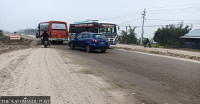National
Nepali and Chinese officials discuss power trade
The northern neighbour proposes constructing a 220kV cross-border line to import electricity from Nepal during winter.
Prithvi Man Shrestha
China has shown interest to purchase electricity from Nepal in winter at a meeting with Nepali officials earlier this week in Kathmandu. The Chinese side also proposed constructing a cross-border transmission line for the purpose, a senior official of the state-owned Nepal Electricity Authority (NEA) said.
During the meeting of the Joint Working Group comprising representatives of the NEA and State Grid Corporation of China, the Chinese side asked how much power Nepal could export to China during winter.
The meeting of the joint mechanism, held in Kathmandu after a gap of three years, concluded on Tuesday.
“The Chinese side asked us whether we could supply power during the winter and how much we could if a cross-border connectivity is established,” said Dirghayu Kumar Shrestha, chief of the transmission directorate of the NEA. “We replied that we will submit our assessment to China during winter.”
According to the Chinese side, power production in Tibet slumps during the winter, just like in Nepal, so they want to import from Nepal. Currently, Nepal witnesses surplus energy during the wet season (rainy season), while facing a shortage of power in the dry season (winter).
So the country has been exporting power to the Indian market in the wet season while importing during the dry months. But Nepal expects to become self-reliant in power even in the winter in the next two years when several new projects start power generation.
Currently, India is the only external market for Nepal to buy and sell electricity. The southern neighbour has also promised to favourably consider Nepal’s plan to export 50MW of electricity to Bangladesh by using Indian transmission infrastructure, as per the agreement reached between Nepal and India during the bilateral talks held in India earlier this week, according to the energy ministry.
Nepal wants to open the door for power trade with China, but there is no transmission line to connect the two sides. Nepal has proposed to construct a 400kV Ratamate-Rasuwagadhi-Kerung Cross-Border Transmission Line Project for electricity trade between the two countries. Nepal has already conducted a feasibility study for this project, whose proposed length is around 70km and can carry 5,000 MW, according to the NEA.
During the meeting, the Chinese side has proposed reducing the carrying capacity of the cross-border power line. “They asked if the capacity of the line can be reduced to 220kV so that the project could be completed quickly.”
Nepal’s 220kV transmission line has reached closer to Rasuwagadhi, which is near the Chinese border. “The Chinese side also said since the 220kV line is already on the Nepali side of the border, they should use the same for power trade,” said Shrestha. “But we told them that a 400kV power line would be better for cross-border power trade.”
Nepal wants to build a high-capacity power line not only for cross-border power trade but also for evacuating power from a growing number of hydropower projects being constructed along the Trishuli corridor.
“Supplying power from all those projects needs a high-capacity line. So this 400kV power line will also help evacuate power for domestic supply,” Komal Nath Atreya, chief of the Ratamate-Rasuwagadhi-Kerung Transmission Line Project told the Post earlier this month.
According to Atreya, a high-capacity cross-border line with China will also make a trilateral electricity trade between Nepal, India and China feasible in the future.
“If the relations between India and China improve, we cannot rule out trilateral power trading through Nepal in the future,” said Atreya.
NEA officials said that the two sides also presented the progress report on cross-border connectivity on either side and the power balance on each side. The Chinese side also observed how NEA’s load dispatch centre works. “No concrete agreement was reached on anything during the meeting, but both sides agreed to talk further on issues raised by each other,” said Atreya.
In March 2020, there had been a discussion of a Joint Technical Group comprising representatives of the NEA and the State Grid Corporation of China before Covid-19 hit the world. The joint mechanism was upgraded to a Joint Working Group last year which comprises a Joint Technical Group and a Joint Commercial Group.
“China has proposed holding the next meeting of the Joint Working Group in Beijing,” Shrestha said.




 13.12°C Kathmandu
13.12°C Kathmandu















